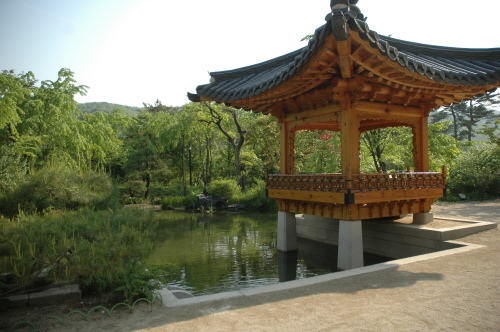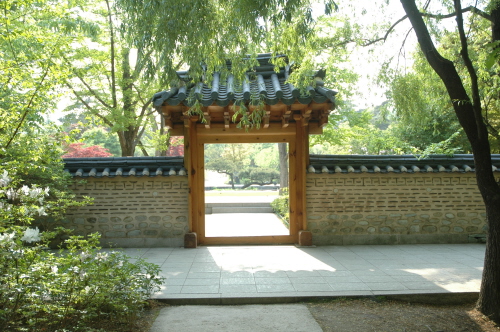Take a walk into the Traditional Garden in Korean Art
Invitation to the Natural World
Take a walk into the Traditional Garden in Korean Art
THE MAGNIFICENT sight of mountains is surrounding a small pavilion. A thick forest composed of fine trees lies in front of the pavilion and graceful willow branches are swaying slowly in the wind. A man strolls in the front yard together with a boy carrying a musical instrument.” Samseung Pavilion, a Korean traditional landscape, portrays a peaceful life found in nature. As expressed in the picture, living with nature was thought to be an ideal lifestyle and often taken as a theme for artwork. Traditional Garden in Korean Art, the 13th special exhibition of Ho-Am Art Gallery, invites you to experience the scenic nature inside the classical paintings.
 | ||
Background and composition
Established in 1982, the Ho-Am Art Gallery had its 15th anniversary in 1997. To celebrate this date, the gallery decided to restore a Korean traditional garden, located within its site. The garden was named Hee Won, meaning “bright garden.” The construction of Hee Won was in accordance with the government’s policy to preserve the nation’s ethnic culture, as 1997 was designated as the “Year of Cultural Heritage.” The following year, the garden won the “Korean Environmental Culture Award.” Commemorating the 10th anniversary of the meaningful opening of Hee Won, the exhibition Traditional Garden in Korean Art is held in the gallery’s special exhibition hall.
Visitors to the exhibition look into what meanings gardens have and how they are expressed in Korean classical paintings. The exhibition is largely divided into four sections: Landscape gardens, Traditional gardens and life, Elements of gardens, and Ideas reflected in gardens. Most displayed artwork belongs to the late Joseon Dynasty, which included the 17th to 19th century. Given the difficulty of preserving old paintings, the exhibition is a rare opportunity to feel the spirits of our Korean artistic predecessors. The exhibits include paintings of Korea’s celebrated traditional painters such as Jeong Seon, Gim Hong-do and Jang Seung-eop.
 | ||
Gardens as idealized nature
‘Landscape gardens,” the theme of the first section, is an expanded concept of gardens in general. A landscape, Sansu-hwa in Korean, literally means a picture that portrays the natural scene, not necessarily that of the individual garden. Still, the exhibition covers Sansu-hwa. For Korean ancestors, the notion of garden was inseparable from that of nature. “Conversation in a hut” of Gang Se-hwang is a shinning example. Two Sunbis, Korean classical scholars, are enjoying a conversation in a thatched hot built on a scenic spot. Then the surrounding landscape itself becomes a garden for the hut. Such landscape gardens were in fashion during the Joeseon Dynasty. Even when their gardens were limited to small yards, Sunbis tried to minimize artificial landscaping and conserve natural beauty. This was called the principle of “borrowed landscape,” because the natural scene was borrowed from nature and incorporated into the garden. This tendency originated from a concept that considers nature as a utopia. Numerous Sunbis dreamed of leading peaceful lives in nature. Especially, the scene of Mt. Muyi, where a legendary Confucial scholar Ahuai had his villa, was regarded as an ideal space and frequently imitated in real gardens and also paintings like Jeong Seon’s “Zhuzi’s Garden in Zhangzhou.”
 | ||
People’s lives in garden
While thought of as an idealized space, a garden, also functioned as a location for daily life. Beyond a mere place for appreciation, Korean gardens were used for some practical purposes, such as greeting guests, holding wedding ceremonies, or serving ancestors. Some pictures in the exhibition vividly revive the lives of previous Koreans. For instance, “View of Gyeonggi Province Office,” (author unknown), illustrates not only typical appearance of official gardens, but also the routines of officers, servants, or merchants. This valuable picture was designated as Treasure No. 1394 by the government. In late 18th century, a renowned Korean artist Gim Hong-do also drew an interesting picture showing the lives of Joeson people in a garden. In his work named “Spring Scene on the Lotus Pond,” the garden served as a romantic place where two lovers had their joyful meeting.
 | ||
A picture outside a picture
After seeing the exhibition hall, visitor might automatically turn their eyes toward beautiful scenery of Hee Won. “Our traditional gardens that still survive today, such as the Secret Garden, or Soswaewon, are not conjoined in that they remain only in separate parts. When constructing Hee Won, we integrated the characteristics of Korean gardens found in various buildings into a complete form,” explains Park Ji-hyun of Administration Dept. of Ho-Am Art Gallery. Hee Won is about 20,000 pyeong wide (66,116 square meter) and includes classical elements of gardens like ponds, pavilions, and stonework items.
The picturesque scenery of Hee Won is surely a hidden delight to the visitors of the exhibition. Nonetheless, it seems that the exhibition lacks a dedicated effort to relate its exhibits to the real garden located outside the hall. If there was more thorough explanation to enhance further understanding of Hee Won through the exhibition, people could appreciate the prominence of classical gardens better. This connection between the exhibition and the real garden should be a highly effective way to improve people’s understanding, since most visitors living in a modernized society are unaccustomed to the traditional aesthetics of gardens. We often say “one can see as much as he knows.”
 | ||
* * *
We are living in an overly “busy” era. Everyday we are required to do more work, and the pressure increases as we grow older. In this society of “pressing matters,” this exhibition suggests to us a different world. The world expressed in traditional Korean art pieces values rest and repose over artificial works or heavy struggles. Visiting Traditional Gardens in Korean Art will enable you to encounter the free spirits of our Korean ancestors.

Where: Ho-Am Art Gallery
When: April 3 ~ Sept. 2
Ticket Price: 4,000 Won
Kim Da-eun
kdanilight@yonsei.ac.kr

